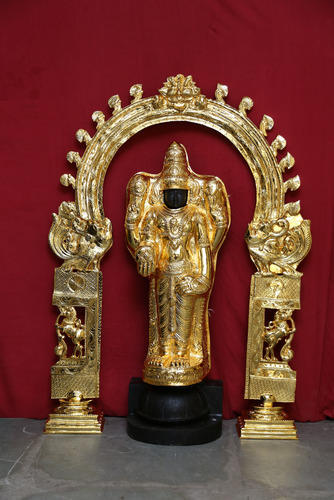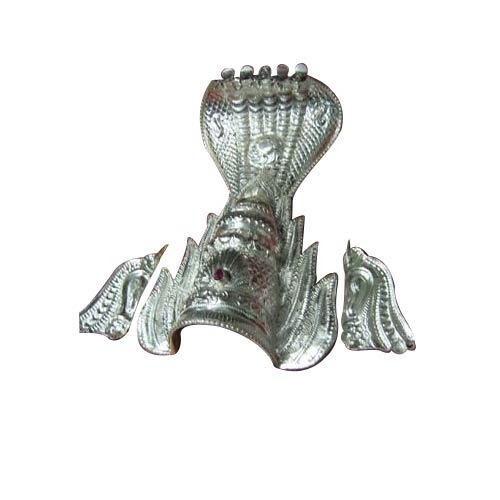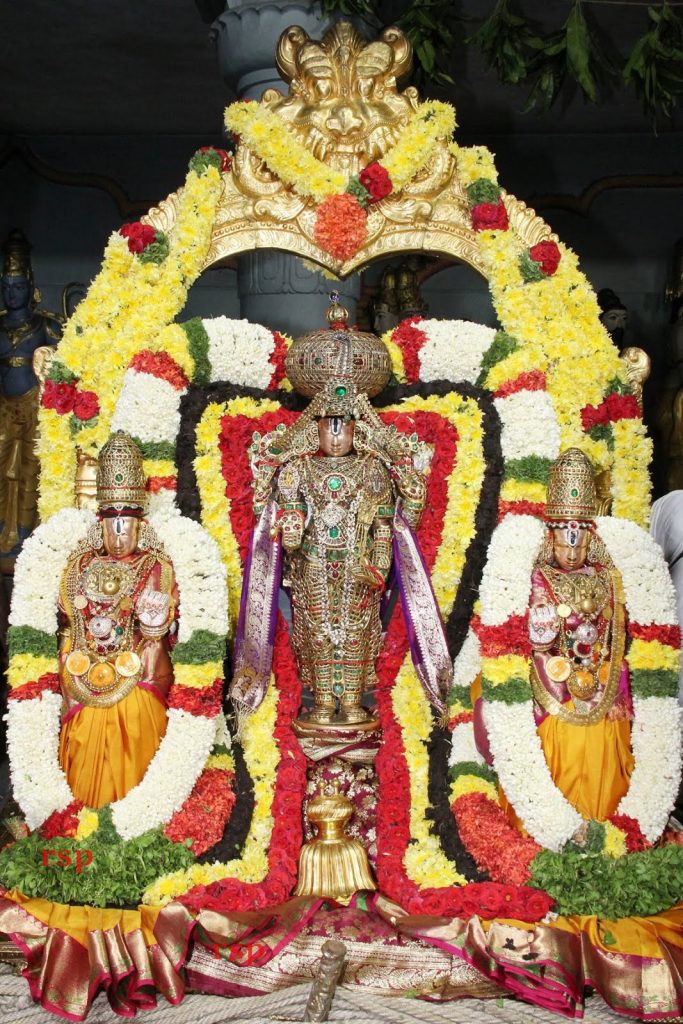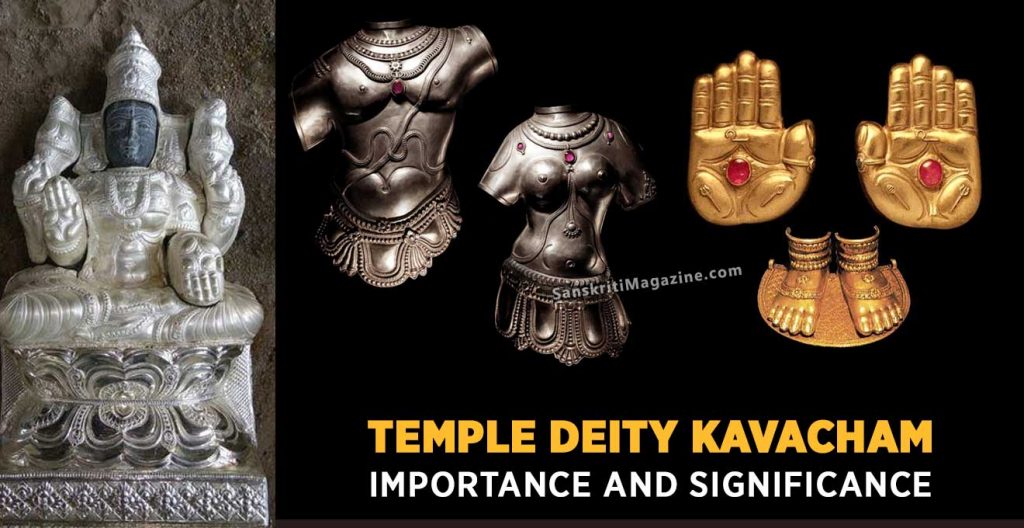In Vaisnava temples throughout India, and particularly in the south, the Deities are sometimes dressed in very opulent coverings, called kavacham (or kavasam). In Gaudiya Vaisnava temples, perhaps the most common examples are Lord Jagannath Deities, who are often adorned with gold or silver hands and feet.
The term kavacham also means ‘armour’, and the word is sometimes used to specifically describe a Deity’s body covering. Such kavacham may be a simple breast-plate or shirt, or it may be an entire body covering, full outfitted with multiple arms and all the Deity’s attendant paraphernalia.
In our recent segment on “Sri Krsna’s Worshipable Ornaments”, we mentioned some of the Lord’s personal jewelry, which is the personification of His personal energy. Likewise, the vigraha coverings for hands, feet and body are considered to be non-different from the Deity Himself.

Generally, kavacham are made by pressing shapes in sheet metal, like brass, copper or silver, and sometimes even gold sheeting. Less precious ornaments may be gold or silver-plated (electro-plated) onto a less expensive base metal sheet. The kavacham are then ornamented, being shaped into beautifully detailed crowns and necklaces, etc., and studded with diamonds, pearls and other precious stones.
These opulent pieces of attire are often only worn by the Deities on special festival days, although in some of India’s wealthiest temples, like Sri Visnu’s abodes at Sri Rangam and Tirumala, the Deities may be found dressed in opulent attire at all times. Such temples are known to have vast treasure-houses that hold the presiding Deity’s jewels and rare items of paraphernalia, as well as money in the treasury and other temple assets. Today, these temples come complete with a cadre of armed guards. In ISKCON, the Deities are generally dressed only in semi-precious stones, to protect the Deities from thieves.
Of course, there are always members of the congregation likely to want to emulate the Lord’s beauty, dressing themselves in whatever ornamentation they can afford. In a recent article on temple jewelry, author Juliet Highest quoted a 12th-century Indian poet who was describing the scene inside a temple:
“People jostled against each other, and as they rubbed chests, sparkling jewels fell from their long pearl necklaces. The floor became studded with tiny stones, and as they tried to step over them so as not to hurt their feet, people seemed to break into dance with every single step.”
 Adorning not only their wives, wealthy donors in the temple community often bring gifts of jewelry for the Deities, or they simply bring loose precious stones and metals for temple jewelers to use in fashioning the desired items. Donated jewelry of low quality will likely be disassembled and melted down, the metal serving as a temple asset for some other use.
Adorning not only their wives, wealthy donors in the temple community often bring gifts of jewelry for the Deities, or they simply bring loose precious stones and metals for temple jewelers to use in fashioning the desired items. Donated jewelry of low quality will likely be disassembled and melted down, the metal serving as a temple asset for some other use.
Just as devotional attire is likely to reflect the temple itself — for example, saris are typically ornamented with a pyramidal ‘temple border’ — devotional jewelry worn by the devotees often reflects the Deity or the temple. Small bejeweled brooches of Radha-Krsna or Lord Jagannath, are common sights in the ISKCON community. More opulent jewelry items may be fashioned to look like barrel-roofed temple gateways, temple spires or gopuram finials. The Deities themselves may wear crowns that reflect the temple architecture, and columns in the temple sanctum are likewise carved with jewel details, encircled with garlands and bands reminiscent of the Deity’s necklaces.
Perhaps nowhere is this phenomenon described more beautifully than in Srila Bhaktivinoda Thakur’s passage in “Nitya-rupa-samstha-panam” (1883), which reads:
 “Holy men to whom God has been pleased to show His spiritual form have often attempted to picture it to their fellow brethren. The picture, whether it be by pencil, chisel, or pen, is always made through the medium of matter, and hence a degree of grossness has all along attended the representations. This emblematic exhibition of spiritual impressions is far from being open to [the] charge of idolatry. Those who rationally conceive the idea of God, and by the assistance of the imagination create an image, are certainly open to the charge.
“Holy men to whom God has been pleased to show His spiritual form have often attempted to picture it to their fellow brethren. The picture, whether it be by pencil, chisel, or pen, is always made through the medium of matter, and hence a degree of grossness has all along attended the representations. This emblematic exhibition of spiritual impressions is far from being open to [the] charge of idolatry. Those who rationally conceive the idea of God, and by the assistance of the imagination create an image, are certainly open to the charge.
There is one absolute truth at the bottom of this important question. It is this: Nature has indeed a relation to the spirit. What is that relation? As far as we have been instructed by the inner Tutor, we may safely say, that spirit is the perfect model and nature is the copy which is full of imperfections. Draw inferences from the side of nature and press them upon the Deity, they will ever remain gross and imperfect. Draw from the spirit inside and push your impressions at first to the mind and then the body, you simply spiritualize them both.
Here is [the] advent of God on the scene of nature. It is then that the model is to be found represented by the corresponding copy in nature. God’s transcendental form also finds its corresponding reflection in nature, and when we worship the Deity, in pure love, in the reflected scenes of Vrindavan. Here the imagination has no play. It is the soul which sees and makes a description in the corresponding phenomena in nature. The spiritual form thus conveyed to us is none but the eternal form of God. The grossness is simply apparent, but all the actions and consequences are fully spiritual.
The man who weeps and dances in felicity when he spiritually sees the beauty of God is certainly translated to the region of spirits for the time and the gross action of his body is but a concomitant manifestation caused by a current of spiritual electricity. Here we find the absolute in the relative, the positive in the negative and spirit in matter. The spiritual form of God is therefore an eternal truth and with all its inward variety, it is one Undivided Unity. What appears to be a contradiction to reason is nothing but the rules of spirit. And the greatest surprise arises when we see full harmony in all those contradictions.”










